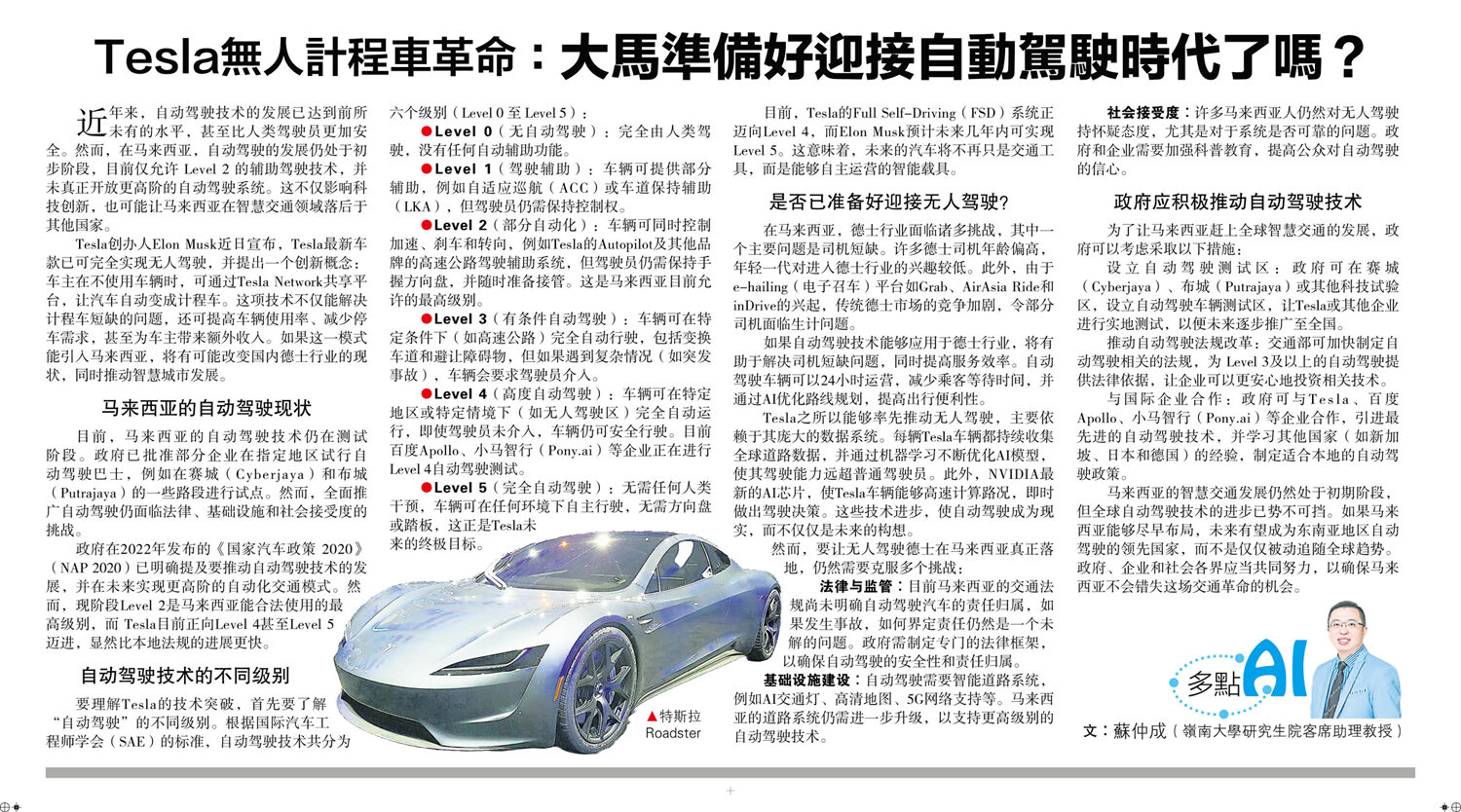AI創業致富證書課程 Kick-Off at Hong Kong Academy of Management
Today’s session at Hong Kong Academy of Management was about showing entrepreneurs and professionals how

Publish on Sin Chew Daily on the 7th of May 2025
In recent years, autonomous driving technology has developed to levels previously unimaginable. Tesla is at the forefront of this revolution. However, despite Elon Musk’s ambitions, autonomous driving is still in its early stages. Currently, Tesla only offers Level 2 assisted driving and has not yet reached true fully autonomous capabilities. But with the support of AI and computing power, we might soon be on the brink of this technological shift, and Malaysia could be preparing to leap forward in transportation development.
Tesla’s founder Elon Musk recently said that Tesla’s new version of Full Self-Driving (FSD) will launch soon, achieving true autonomous driving. Once the vehicle enters autonomous mode, it can be summoned via the Tesla Network. This indicates the future of mobility may no longer rely on personal vehicle ownership. Instead, through intelligent scheduling and cloud systems, users can access mobility as a service—summoning a car when needed, using it, and releasing it afterwards. If realized, this could greatly improve transportation efficiency and reduce traffic congestion.
Currently, Malaysia’s autonomous driving technology remains in its testing and trial phase. The government is encouraging local businesses to build ecosystems for autonomous driving. For example, in Cyberjaya and Putrajaya, road tests and pilot programs for autonomous vehicles are already being conducted. But the country still faces challenges in regulation, infrastructure, and public acceptance.
The Malaysian government launched the “National Automotive Policy 2020” (NAP 2020), emphasizing the future development of Next Generation Vehicles (NxGV), including electric and autonomous vehicles. However, the implementation of such a vision still faces obstacles, particularly in public awareness and acceptance. Tesla’s system currently lies between Level 4 and Level 5 autonomy, and full realization is still in development.
To understand the development of autonomous driving technology, one must first be familiar with the six levels of automation, as defined by the Society of Automotive Engineers (SAE):
Tesla’s FSD system is approaching Level 4, and Elon Musk predicts full Level 5 capability could be realized in the near future. The future is not merely about transportation but about reimagining mobility through smart robotics.
Malaysia faces many challenges. On one hand, e-hailing services such as Grab, AirAsia Ride, and inDrive are changing traditional transportation habits. On the other hand, traffic congestion and long commutes remain issues in major cities.
If autonomous driving technology can be deployed for public use, it could assist city planners in optimizing traffic flow, improving mobility efficiency, and reducing carbon emissions. This shift requires not only strong infrastructure but also changes in user behavior and mindset.
Tesla’s biggest challenge is not in software or AI models, but in real-world data collection. The system must learn to adapt to different environments, which requires vast road testing. Tesla has already deployed its FSD Beta to over one million cars in North America and continues to refine its systems through real-time data.
For Malaysia, readiness depends on multiple factors:
Malaysia is still in the early stages of the autonomous driving era. But this presents a golden opportunity to catch up. With the right government policies, infrastructure support, and public-private collaboration, Malaysia can leapfrog into this next-generation transportation ecosystem.
This transition won’t happen overnight, but the seeds are already being planted. The hope is that through partnerships with global leaders like Tesla and local innovators, Malaysia can become a future hub for smart mobility in Southeast Asia.
Tesla 无人计程车革命:马来西亚是否已准备好迎接自动驾驶时代?
近年来,自动驾驶技术的发展已达到前所未有的水平,甚至比人类驾驶员更加安全。然而,在马来西亚,自动驾驶的发展仍处于初步阶段,目前仅允许 Level 2 的辅助驾驶技术,并未真正开放更高阶的自动驾驶系统。这不仅影响科技创新,也可能让马来西亚在智慧交通领域落后于其他国家。
Tesla 创办人 Elon Musk 近日宣布,Tesla 最新车款已可完全实现无人驾驶,并提出一个创新概念:车主在不使用车辆时,可通过 Tesla Network 共享平台,让汽车自动变成计程车。这项技术不仅能解决计程车短缺的问题,还可提高车辆使用率、减少停车需求,甚至为车主带来额外收入。如果这一模式能引入马来西亚,将有可能改变国内的士行业的现状,同时推动智慧城市发展。
目前,马来西亚的自动驾驶技术仍在测试阶段。政府已批准部分企业在指定地区试行自动驾驶巴士,例如在赛城(Cyberjaya)和布城(Putrajaya)的一些路段进行试点。然而,全面推广自动驾驶仍面临法律、基础设施和社会接受度的挑战。
政府在 2022 年发布的 《国家汽车政策 2020》(NAP 2020) 已明确提及要推动自动驾驶技术的发展,并在未来实现更高阶的自动化交通模式。然而,现阶段 Level 2 是马来西亚能合法使用的最高级别,而 Tesla 目前正向 Level 4 甚至 Level 5 迈进,显然比本地法规的进展更快。
要理解 Tesla 的技术突破,首先要了解「自动驾驶」的不同级别。根据国际汽车工程师学会(SAE)的标准,自动驾驶技术共分为六个级别(Level 0 至 Level 5):
目前,Tesla 的 Full Self-Driving(FSD)系统正迈向 Level 4,而 Elon Musk 预计未来几年内可实现 Level 5。这意味着,未来的汽车将不再只是交通工具,而是能够自主运营的智能载具。
在马来西亚,的士行业面临诸多挑战,其中一个主要问题是司机短缺。许多的士司机年龄偏高,年轻一代对进入的士行业的兴趣较低。此外,由于 e-hailing(电子召车)平台如 Grab、AirAsia Ride 和 inDrive 的兴起,传统的士市场的竞争加剧,令部分司机面临生计问题。
如果自动驾驶技术能够应用于的士行业,将有助于解决司机短缺问题,同时提高服务效率。自动驾驶车辆可以 24 小时运营,减少乘客等待时间,并通过 AI 优化路线规划,提高出行便利性。
Tesla 之所以能够率先推动无人驾驶,主要依赖于其庞大的数据系统。每辆 Tesla 车辆都持续收集全球道路数据,并通过机器学习不断优化 AI 模型,使其驾驶能力远超普通驾驶员。此外,NVIDIA 最新的 AI 芯片,使 Tesla 车辆能够高速计算路况,即时做出驾驶决策。这些技术进步,使自动驾驶成为现实,而不仅仅是未来的构想。
然而,要让无人驾驶的士在马来西亚真正落地,仍然需要克服多个挑战:
为了让马来西亚赶上全球智慧交通的发展,政府可以考虑采取以下措施:
马来西亚的智慧交通发展仍然处于初期阶段,但全球自动驾驶技术的进步已势不可挡。如果马来西亚能够尽早布局,未来有望成为东南亚地区自动驾驶的领先国家,而不是仅仅被动追随全球趋势。政府、企业和社会各界应当共同努力,以确保马来西亚不会错失这场交通革命的机会。
Today’s session at Hong Kong Academy of Management was about showing entrepreneurs and professionals how
在人工智慧技術飛速發展的當下,算力基建、智慧財產權保護與開源共用正成為創新領域的焦點議題。近日,筆者以香港浸會大學專利顧問委員會成員的身份,見證於北京舉行的華為2025年創新和智慧財產權論壇,親身感受這場以“開放驅動創新”為主題的思想碰撞。論壇上,華為發佈了第六屆“十大發明”評選結果,涵蓋計算、作業系統、存儲等面向未來的關鍵技術領域。其中最引人注目者,莫過於名列首位的“Scale-up超大規模超節點算力平臺”——一套超級算力系統,被譽為人工智慧時代的新型基礎設施。本文將結合論壇見聞和筆者實務經驗,觀察該超級算力在AI時代的基建角色,探討“開源共用”與“智慧財產權保護”對創新的雙重意義,並反思香港在創新基建、產學研轉化、專利文化等方面的瓶頸與出路。 超級算力集群:AI時代的基建底座 這款被華為評為年度十大發明之首的Scale-up超大規模超節點算力平臺,實質上是由眾多AI處理器組成的單一邏輯超級電腦。隨著AI模型規模指數級增長,訓練這些模型所需的算力和資料輸送量呈爆炸式上升。傳統的伺服器堆疊模式面對超大型AI任務時,往往出現“ 集群越大、有效算力利用率反而越低,訓練中斷越頻繁”的窘境。華為針對此痛點創新出“超節點”系統架構,具備資源池化、線性擴展和高可靠性等特性:通過統一高速協定和共用記憶體編址,打通計算與存儲單元的高頻寬低時延互聯,使有效算力可隨節點規模近乎線性增長,同時大幅提升集群穩定性。華為輪值董事長徐直軍強調:“算力是——而且將繼續是——AI的關鍵”。基於對這一點的共識,華為推出了新一代Atlas系列超節點產品,其中Atlas 950 SuperPoD即對應此次的Scale-up超級算力。該平臺面向超大型AI訓練任務,從基礎器件、協定演算法到光電互聯均實現了系統級創新。例如,它採用正交架構設計實現零線纜的電氣互連,搭配全液冷散熱與浮動盲插技術確保不滲漏,同時首創UB-Mesh遞迴直連拓撲,支持單板內、板間、機架間NPU全互聯,以64卡為模組靈活擴展,最大可支援8192顆昇騰AI處理器無收斂互聯。換言之,上千顆AI晶片可彙聚成“一個大腦”協同運算,真正消除超大規模訓練的瓶頸。 從實踐看,超級算力已不僅是實驗室概念,而成為產業AI生態的基礎底座。華為透露,截至目前其上一代Atlas 900系列超節點系統已累計部署超過300套,服務於互聯網、金融、電信、電力、製造等行業的20多家客戶。在人工智慧時代,類似Atlas 950這樣的本地智算樞紐,相當於數字經濟的高速公路與電力網絡:為產業生態提供共用的算力資源,降低創新應用部署門檻,有力支撐從雲服務到垂直行業落地的AI解決方案。尤其對中國而言,在先進晶片供給受限的背景下,華為選擇利用現有制程自研超大規模計算平臺,以系統工程突破彌補晶片性能不足,體現出以基建思維佈局AI長遠發展的戰略定力。 “開放共用”與“智慧財產權”:雙軌驅動創新的辯證 本屆論壇傳遞出一個明確訊息:開源合作和智慧財產權保護並非對立,而是創新發展的雙引擎,需同步推進、制度協調。華為首席法務官宋柳平在會上表示:“開放創新是推動社會發展和技術進步的重要力量,也是華為的DNA。華為一直在踐行‘開放’的理念,用開放驅動創新。同時,華為注重自有智慧財產權的保護,也尊重他人的智慧財產權,包括專利、商標、版權和商業秘密等。”簡言之,一方面積極參與開源與共用,另一方面嚴格保障智慧財產權,兩條路並行不悖。華為近年來在專利研發和佈局上不遺餘力。2024年華為專利授權收入約6.3億美元,同時其歷年累計支付的專利許可費是自身許可收入的三倍之多。根據世界智慧財產權組織統計,華為2024年通過PCT公開的國際專利申請達6600件,自2014年以來連續位居全球首位。僅2024年一年,華為新公開專利就達3.7萬件,創下歷史新高。強大的專利庫讓華為在5G、Wi-Fi、視頻編碼等領域建立了廣泛的授權生態:截至2024年底,全球已有超過27億台5G設備、12億台消費電子設備和32億台多媒體設備獲得華為專利授權,全球500強企業中有48直接或間接獲得華為的授權許可。 另一方面,華為在開源開放方面同樣投入巨大資源。其副總裁、智慧財產權部部長樊志勇指出,華為透過“軟體開源、硬體開放、專利申請、標準貢獻與學術論文等多種形式”推動技術開放。2024年華為向標準組織新提交技術提案超1萬篇,發表學術論文逾1000篇;在開源社區方面,主導或參與了多個大型專案,例如OpenHarmony開源作業系統社區已有超過8100名共建者;openEuler開源OS發行版本累計裝機量已突破1000萬套;並將昇騰AI基礎軟體棧全面開源,包括CANN計算架構和MindSpore深度學習框架,並優先適配主流開源社區如PyTorch、vLLM等。 由此可見,“智慧財產權保護”保障了創新者的投入回報和商業動力,而“開源共用”則能彙聚眾智加速技術成熟與應用擴散。兩者並非水火不容,關鍵在於尋求制度性的平衡與協同。正如香港大學鄧希煒教授所言,一個強健、開放且受國際信賴的專利體系是創新引擎運轉不可或缺的條件。 全球範圍內,“開源”與“封閉”的博弈亦在演變。NVIDIA以CUDA軟體平臺構建封閉生態,形成極高的市場壁壘與利潤迴圈,但OpenAI從開源轉向封閉的過程亦引發反思。當Meta等公司以Llama開源模型崛起,開源生態再次展現強勁生命力。這些案例共同說明:唯有平衡專利保護與開源合作,才能讓科技創新在競爭與共榮中持續演進。 香港創新生態的瓶頸與建議
AiX Society is thrilled to congratulate our valued partner, Midas Analytics, for winning the prestigious
HKOEA Consultancy
Licence No. 59684
© 2025 Artificial Intellegence Application Research Society. All rights reserved
by Originals Group – Hong Kong, Malaysia, GBA